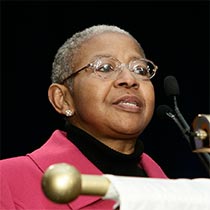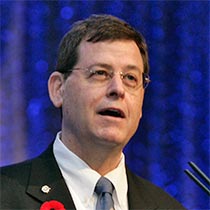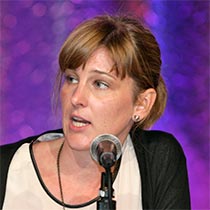Monday, Oct. 17
8:00 am–8:45 am
43rd Donald F Egan Scientific Memorial Lecture

8:00 am–8:45 am | Room TBA | Adult Critical Care
ECMO: Where Have We Been and Where Are We Going?
Ira M Cheifetz MD FAARC FCCM, Durham NC
The technologic and management aspects of extracorporeal life support (ECLS), including extracorporeal membrane oxygenation (ECMO), have advanced more in the past five years than any other aspect of critical care medicine. ECLS devices are smaller, simpler, and safer than just a few years ago. The application of this technology has led to these critically ill patients being maintained awake and, in some circumstances, even ambulatory. This presentation will provide an overview of the history of ECLS and ECMO, discuss the current state of the field, and explore the potential future applications of this life-saving technology.
8:50 am–9:20 am | Room TBA
Flag Folding Ceremony

An AARC tradition like no other, attend the AARC Flag Folding Ceremony and celebrate the rich tradition of the U.S. Military and Armed Forces. RT Veterans and active duty respiratory therapists conduct a moving ceremony as we recognize those who serve, those who have served and those we have lost.
9:15 am–12:25 pm
Student Symposium for Young Professionals

9:15 am–9:45 am | Room TBA
What It Means To Be a Professional
Crystal Dunlevy EdD RRT, Columbus OH
This presentation will provide an overview of the profession of respiratory care, including its history, evolution, role, and value. Emphasis will be placed on the characteristics and behaviors of a professional and the critical importance of being involved and engaged in the profession and maintaining professional membership.

9:50 am–10:25 am | Room TBA
Strategic Marketing: Getting That Dream Job
Cheryl Hoerr MBA RRT CPFT FAARC
This presentation will provide an explanation of the value of marketing and how you can use key marketing principles to position yourself for your dream job. We will discuss trends in the respiratory field and show how to gather detailed information about the companies you would like to work for. We will also outline techniques to conduct an effective job search, along with a brief overview on how to develop your cover letter and resume and prep for that all-important interview.

10:30 am–11:05 am | Room TBA
How To Lose a Job Before You Are Hired
Dana Evans MHA RRT-NPS, Chesterfield MO
You have just landed an interview for your dream job. You are nervous, excited, and really want to impress the hiring leader. Did you know you could lose the job before you even arrive to the interview? The presenter will discuss common mistakes and pitfalls of job seekers, including those that may cost you the position before you are hired.

11:10 am–11:45 am | Room TBA
Acquiring Your Credential: Success on the Therapist Multiple-Choice Exam
Bill Galvin MSEd RRT CPFT AE-C FAARC, Gwynedd PA
The presentation will address the factors that make for success in the examination process. It will cover preparatory issues and what you will experience onsite, as well as test-taking strategies and techniques. Emphasis will be placed on the new Therapist Multiple-Choice Examination (TMC) implemented by the NBRC in January 2015.

11:50 am–12:25 pm | Room TBA
Acquiring Your Credential: Success on the Clinical Simulation Exam
Bill Galvin MSEd RRT CPFT AE-C FAARC , Gwynedd PA
This presentation will serve as a sequel to the previous one and will address the factors that make for success on the Clinical Simulation Examination. It will cover such issues as exam content, structure, and unique strategies for progressing through a branching logic type of exam. It will also highlight recent changes implemented in January 2015.
9:30 am–11:55 am
Open Forum Editors' Choice

9:30 am–9:43 am | Room TBA
Editor's Choice 1
9:45 am–9:58 am | Room TBA
Editor's Choice 2
10:00 am–10:13 am | Room TBA
Editor's Choice 3
10:15 am–10:28 am | Room TBA
Editor's Choice 4
10:30 am–10:43 am | Room TBA
Editor's Choice 5
10:45 am–10:58 am | Room TBA
Editor's Choice 6
11:00 am–11:13 am | Room TBA
Editor's Choice 7
11:15 am–11:28 am | Room TBA
Editor's Choice 8
11:30 am–11:43 am | Room TBA
Editor's Choice 9
11:45 am–11:58 am | Room TBA
Oxygen is Oxygen... Is There Really a Difference Outside the Hospital’s Four Walls?
9:55 am–10:25 am | Room TBA
Surface To Air Transport Section Membership Meeting

Section members meet to determine their needs and priorities, as well as how to use AARC resources to accomplish them. All Congress attendees, including section non-members, are invited to attend and participate.
9:55 am–10:25 am | Room TBA
Adult Acute Care Section Membership Meeting

Section members meet to determine their needs and priorities, as well as how to use AARC resources to accomplish them. All Congress attendees, including section non-members, are invited to attend and participate.
10:00 am–2:30 pm | Room TBA
Open Forum Posters Only #2
Researchers and clinicians present the results of their work in this Posters Only session. Authors available from 12:00 pm - 1:30 pm for questions and interaction.
Supported by an unrestricted education grant from
10:30 am–11:05 am | Room TBA | Clinical Practice
Oxygen Is Oxygen... Is There Really a Difference Outside the

Kim Wiles BS RRT, Ford City PA
Differences in oxygen therapy exist between the hospital and the home. This lecture will discuss the differences and why the acute care RT needs to have an understanding in order to ensure that patients are successfully transitioned to the home.
10:30 am–11:05 am | Room TBA | Clinical Practice
Long-Term Oxygen Therapy Trial: An Expanded Role for Oxygen Therapy: Yea or Nay?

Eduardo Mireles-Cabodevila MD, Cleveland OH
This talk will review the use of cough augmentation technology as both a therapeutic means and an assessment tool. A case study will be described that addresses these issues.
10:30 am–11:05 am | Room TBA | Clinical Practice
Transport Education: Who Sets the Standards?

Tabatha Dragonberry BSRT RRT-NPS AE-C, Fresno CA
Respiratory care education has been a topic of discussion as we move towards 2020. The standards are changing for our profession, which generates the question: How does this change effect transport RTs? What are the standards we should be following to provide safe, competent care for patients who require inter-facility transport? This lecture will discuss transport education and what standards we should follow as we move to advance the profession.
10:30 am–11:05 am | Room TBA | Clinical Practice
E-valuating the E-vidence for E-ducating Smokers Quitting Wi

Georgianna Sergakis PhD RRT TTS FAARC, Columbus OH
Do e-cigarettes have potential as a cessation aid? This presentation will examine the research evidence and discuss any role e-cigarettes might play in smoking cessation. We will also explore emerging issues and discuss the role of the respiratory therapist in providing health information regarding e-cigarette use.
10:30 am–11:05 am | Room TBA | Management
Tell Me Something I Should Know…Faculty Development

Peggy Watts MS RRT, Saint Louis MO
Historically, RTs were selected to serve as department-based educators based upon their excellent clinical skills. However, as we have matured as a profession, it is more important than ever to ensure that our educators have the training and skills to be successful.
10:30 am–12:25 pm
Lung Protection - Noninvasive Respiratory Support

10:30 am–11:05 am | Room TBA | Adult Critical Care
What Is the Role of HFNC in Preventing Intubation and NIV?
Masaji Nishimura PhD MD, Tokushima Japan
High flow nasal oxygen washes out the upper airway dead pace reducing the ventilatory requirement. The additional heat and humidity allows the patient to tolerate a high flow from a traditionally low flow device. What is the role and what is the evidence that HFNC can prevent or reduce the need for NIV or invasive ventilation?

11:10 am–11:45 am | Room TBA | Adult Critical Care
Graduate School: What? When? Why? How? Where? The Experience of RTs Who Have Done It
John Davies MA RRT FAARC, Durham NC
NIV is a standard of care for COPD exacerbations to prevent intubation and reduce mortality. In what other conditions can NIV successfully prevent intubation and reduce VILI?

11:50 am–12:25 pm | Room TBA | Adult Critical Care
When Does Lung Protection Begin - the ED or the OR?
Lorenzo Berra MD, Boston MA
Lung protective ventilation is the standard of care for ARDS. How early should lung protection begin? What is the evidence for lung protection in the operating room? What is the evidence for lung protection in the emergency department?
10:30 am–3:00 pm
Five Things I Learned in 2015

10:30 am–11:05 am | Room TBA | Neonatal/Pediatric
Pediatric Safety and Quality Improvement
Michael Anderson MD MBA, Cleveland OH
Patient safety and quality improvement are the key underlying foundations for all patient care. This presentation will review key initiatives and strategies to optimize patient safety and quality improvement in the neonatal and pediatric populations. Strategies which can be universally implemented in hospitals of all types will be discussed.

11:10 am–11:45 am | Room TBA | Neonatal/Pediatric
COPD Case Management Led by RTs Reduces Readmissions
Amber Galer BS RRT, West Point UT
Pediatric sleep disorders represent highly common phenomena that often interfere with daily patient and family functioning. Interest in and treatment of sleep disturbances in youth continues to increase, but research continues to lag. This presentation will provide an evidence-based review of the current approach to pediatric sleep medicine and will explore strategies to improve clinical outcomes.

11:50 am–12:25 pm | Room TBA | Neonatal/Pediatric
Building Bridges Across the Continuum of Care - New Models of Care
Brooke Yeager MSc RRT, Charleston SC
The newly developing field of telemedicine has the potential to benefit pediatric clinical care by broadening the access to pediatric specialists and services. This presentation will explore the current uses and limitations of telemedicine in pediatrics. Thoughts for future applications of this emerging technology will be explored.
11:10 am–11:45 am | Room TBA | Patient Safety
What Goes Wrong in Home Care?

Angela King BS RPFT RRT-NPS, Leo IN
What goes wrong in home care? Overloaded electrical circuits, power failures, inadequate caregiver training, faulty alarm settings - all are potentially deadly occurrences. The FDA MAUDE database provides information about serious patient incidents. This lecture reviews serious patient incidents over the past 10 years and offers strategies for enhancing patient safety.
11:10 am–11:45 am | Room TBA | Clinical Practice
COPD Case Management Led By RTs Reduces Readmissions

Krystal Craddock RRT-NPS CCM, Elk Grove CA
This lecture will give you a look at what RT COPD case managers at UC Davis have been doing to improve patient education and facilitate health care navigation and utilization to achieve better outcomes and cost savings. A review of the COPD case management program including education, medication and treatment recommendations, and follow-up after discharge, along with four year data on readmission rates and cost savings will be presented.
11:10 am–11:45 am | Room TBA | Adult Critical Care
Transport of the Trauma Patient

Joe Hylton BSRT RRT-ACCS RRT-NPS NREMT-P FAARC FCCM, Charlotte NC
Trauma patients are often the most tenuous and usually require transport to an alternate facility better equipped to manage the patient's injuries. This presentation will cover the key challenges in inter-hospital transport. Strategies will be provided on how to avoid common pitfalls and mistakes.
11:10 am–11:45 am | Room TBA | Clinical Practice
Oh, the Places You'll Go!

Lisa M Trujillo DHSc RRT, Ogden UT
Despite being a children's book, ?Oh, the Places You'll Go?, by Dr. Seuss provides an interesting parallel to the opportunities, challenges, and experiences that come with international medical missions and service learning. This presentation will explore these similarities and the underlying message of creating your own path regardless of the influence of others, the paths they choose, and the difficulties that may arise along the way. In the words of Dr. Seuss, "You're off to great places! Today is your day! Your mountain is waiting, so get on your way!"
11:10 am–11:45 am | Room TBA | Management
Ethics at End of Life: Talking About Palliative Care and Hospice

Sarah L Varekojis PhD RRT FAARC, Columbus OH
Many professions and organizations rely on volunteers to accomplish at least part of their mission and respiratory therapy is no different. This presentation will address how RTs can learn to foster professional volunteerism across the continuum.
11:50 am–12:25 pm | Room TBA | Adult Critical Care
Long-Term Oxygen Therapy Trial: An Expanded Role for Oxygen

Neil MacIntyre MD, Durham NC
Results are still under embargo. The LOTT study is designed to evaluate the role of supplemental oxygen in patients with borderline resting hypoxemia or hypoxemia only with exercise. The study is co-funded by NIH and Medicare. Results of the trial will be presented.
11:50 am–12:25 pm | Room TBA | Clinical Practice
Building Bridges Across the Continuum of Care - New Models O

Charity Clark MSHROD BS RRT, Wichita KS
As health care changes, organizations are looking for new models of care to help provide quality transitional care and reduce core measure readmissions. This presentation will share the process and outcomes of two innovative new models of care to assist patients with COPD across the continuum.
11:50 am–12:25 pm | Room TBA | Clinical Practice
Drones and Medical Transport

Jennifer L Watts BS RRT-NPS C-NPT, Oak Lawn IL
With the popularity of drones, medical transport faces another factor to be aware of during transport. Situational awareness during transport now has to be cognizant of the recreational flyer.
11:50 am–12:25 pm | Room TBA | Patient Safety
Reducing Nuisance Alarms

Kevin McQueen MHA RRT CM, Oceanside CA
Nuisance alarms are a part of everyday life in the hospital setting and have been increasing as new technology has appeared. While alarms are obviously needed to notify staff of a problem or change in a patient's condition, nuisance alarms can negatively impact their care. This presentation will look at ways to reduce these alarms.
11:50 am–12:25 pm | Room TBA | Management
Tired of Communicating? Try Negotiating

Karsten Roberts MS RRT-ACCS RCP, Stanford CA
Negotiation is a key skill for the critical thinking RT. Although similar to communication skills, negotiation differs in important ways. Negotiating plans of patient care can enhance quality and increase patient safety. This lecture describes the integration of negotiation skills into the clinical education of newly hired respiratory care practitioners.
12:30 pm–2:25 pm | Room TBA
Open Forum Poster Discussion #9 Ventilation/Ventilators, Par
Researchers and clinicians present findings of studies on aerosol therapy, mechanical ventilation, neonatal and pediatric care, education, management, and every other mode of practice in our profession.
Supported by an unrestricted education grant from
12:30 pm–2:25 pm | Room TBA
The Impact of Hypobarism on ET Tube Cuff Pressure: What Can Be Done?
Researchers and clinicians present findings of studies on aerosol therapy, mechanical ventilation, neonatal and pediatric care, education, management, and every other mode of practice in our profession.
Supported by an unrestricted education grant from
1:15 pm–1:45 pm | Room TBA
Education Section Membership Meeting

Section members meet to determine their needs and priorities, as well as how to use AARC resources to accomplish them. All Congress attendees, including section non-members, are invited to attend and participate.
1:15 pm–1:45 pm | Room TBA
Continuing Care/Rehab Section Membership Meeting

Section members meet to determine their needs and priorities, as well as how to use AARC resources to accomplish them. All Congress attendees, including section non-members, are invited to attend and participate.
1:45 pm–2:20 pm | Room TBA | Education
Open Your Eyes To Your Blind Spots

Crystal Dunlevy EdD RRT, Columbus OH
Are you able to assess your patients, co-workers, and students in a fair and accurate way? This presentation will address hidden biases that we all possess based on a lifetime of experience and exposure. Implicit bias and the impact it can have on patient care and daily interactions will be discussed; mechanisms for reducing implicit bias will be presented.
1:45 pm–2:20 pm | Room TBA | Pulmonary Function
The Approach to Tobacco Dependence Treatment • Part 1: Understanding Behavioral Interventions

Matthew O'Brien MS RRT RPFT, Madison WI
Lung clearance index is a PFT calculation that holds promise to help improve our understanding of ventilation and small airway function. Could future orders include LCI pre- and post-bronchodilator?
1:45 pm–2:20 pm | Room TBA | Management
Stop Focusing on Volume and Cost!

Cheryl Hoerr MBA RRT CPFT FAARC, Rolla MO
We've been hearing it for years now: quality care is lower cost care. Why then do we continue to focus our efforts on maintaining volume and cutting costs, emphasizing productivity and cutting staff, and making purchasing decisions in large part on the basis of cost? Respiratory managers should be focusing on overuse of ineffective care while streamlining processes to minimize waste. The manager for the future must emphasize safety, quality, patient outcomes, and patient experiences in order to successfully position their department in the new health care environment.
1:45 pm–3:40 pm
Transitional Care - Hospital To Home

1:45 pm–2:20 pm | Room TBA | Clinical Practice
E-valuating the E-vidence for E-ducating Smokers Quitting with E-cigarettes
Charity Clark MSHROD BS RRT, Wichita KS
The patient's success in transitioning from the hospital to home is found in new models of care focusing on chronic disease management. These programs are innovative with a patient-centered, relationship-based care approach that assists the patient in decreasing exacerbations and hospitalizations while improving quality of life.

2:25 pm–3:00 pm | Room TBA | Clinical Practice
Pulmonary Rehabilitation: A Year in Review
Brian Carlin MD, Sewickley PA
Want to know where the field is going? Attendees can expect an overview of some of the most important research findings in pulmonary rehabilitation. Clinicians would be hard pressed to find a more comprehensive, concise update.

3:05 pm–3:40 pm | Room TBA | Clinical Practice
Oxygen: The PR Drug of Choice
Trina Limberg BS RRT FAARC, San Diego CA
Assessing and understanding your PR patient's oxygen requirement is very important. A PR program must know how to assess oxygen needs at home and with exercise, and how to integrate this into the patient's care plan.
1:45 pm–4:20 pm
The State of Tobacco and Nicotine Dependence

1:45 pm–2:20 pm | Room TBA | Clinical Practice
The Approach To Tobacco Dependence Treatment - Part 1: Under
Frank Leone MD MS
This session will set the foundations for tobacco dependence treatment strategies by reviewing the neurobiology of nicotine addiction and the resulting behavioral manifestations of dependence. Participants will learn a simple framework for overcoming the natural ambivalence of dependence, including the often frustrating resistance to stop smoking.

2:25 pm–3:00 pm | Room TBA | Clinical Practice
Tobacco Cessation Pharmacotherapy Part 1: Non-Nicotine Pharmacotherapy
Frank Leone MD MS, Philadelphia PA
If smoking causes so much preventable death and disability, why do members of the health care community still feel so helpless to make a difference? Social scientists have helped shed light on human decision-making under conditions of uncertainty. But how can we use this insight to promote institutional change in our approach to tobacco treatment? This lecture will review data incorporating these social science insights into tobacco dependence treatment training strategies and describe the impact on the clinician's "willingness to treat."

3:05 pm–3:40 pm | Room TBA | Clinical Practice
Tobacco Cessation Pharmacotherapy Part 2: Nicotine Replacement Therapy
Lori Wilken PharmD BCACP TT-S AE-C, Chicago IL
Counseling patients on tobacco cessation is an important aspect of the RT?s role in health care. This presentation will address key issues in pharmacotherapy for tobacco cessation which, in turn, will help the RT maximize the cessation conversation and help the patient quit.

3:45 pm–4:20 pm | Room TBA | Clinical Practice
Patient Safety: Understanding the “Second Victim” of Medical Error
Lori Wilken PharmD BCACP TT-S AE-C, Chicago IL
Continuing the discussion of tobacco cessation pharmacotherapy, this presentation will address nicotine replacement therapy specifically, including side effects and combination therapy.
1:45 pm–3:00 pm
PRO/CON Dueling Experts


1:45 pm–3:00 pm | Room TBA | Adult Critical Care
Forty Years of High Frequency Ventilation: More Noise than Light
PRO: Dean R Hess PhD RRT FAARC, Boston MA
CON: Richard Branson MSc RRT FAARC Cincinnati OH
This lecture will present the benefits of volume control to ventilate a patient with ARDS by two of the most prominent clinicians in our profession.
1:45 pm–3:00 pm
Pediatric Emergency Management in a Community Hospital Setting

1:45 pm–2:20 pm | Room TBA | Neonatal/Pediatric
Preparing for the "N-of-1" Pediatric Disaster
Michael Anderson MD MBA, Cleveland OH
Although disaster management preparation is generally focused on mass casualty scenarios, planning for the "N-of-1" situation of a critically ill child presenting to an adult emergency department must be considered. This presentation will describe the N-of-1 disaster situation as well as strategic planning approaches to help adult-based EDs prepare for this vulnerable situation. Appropriate planning can potentially save the life of an infant or child.

2:25 pm–3:00 pm | Room TBA | Neonatal/Pediatric
Putting Lessons Learned From My Pediatric Rotation Into Prac
Teresa A Volsko MHHS RRT FAARC, Akron OH
The respiratory therapist is often asked to initiate the management of patients with respiratory emergencies, which can range from infection to the presence of a foreign body to the acute exacerbation of a chronic condition. This presentation will review the most common pediatric diagnoses encountered in the emergency rooms of community-based hospitals, as well as clinical options related to treatment and stabilization before transfer to a tertiary care center. Common clinical encounters and interventions with a focus on evidenced-based management will be discussed.
–


1:45 pm–3:00 pm | Room TBA | Adult Critical Care
PRO/CON: ECMO Should Be Regionalized
PRO: Ira M Cheifetz MD FAARC FCCM, Durham NC
CON: Keith D Lamb RRT-ACCS FCCM Des Moines IA
ECMO use has exploded in multiple centers and for a number of indications from cardiac and respiratory failure to cardiac arrest. ECMO requires expensive equipment and significant manpower. Should this capability be regionalized or can any hospital start an ECMO program?


3:05 pm–4:20 pm | Room TBA | Adult Critical Care
PRO/CON: ECMO Should Be Reserved for Rescue Therapy
PRO: Neil Macintyre MD, Durham NC
CON: Robert M Kacmarek PhD RRT Littleton MA
ECMO has been touted as life-saving therapy since the 1970s. Should ECMO remain the last response after patients have failed other treatments for refractory hypoxemia, or should ECMO be used early?
2:25 pm–3:00 pm | Room TBA | Education
Landing a New Advanced Respiratory Therapist Role

Ellen Becker PhD RRT-NPS FAARC, Chicago IL
You have a few years of respiratory care experience under your belt and are ready to advance your career. What are your options? What educational preparation is required? What other strategies are needed to land your coveted new role?
2:25 pm–5:00 pm
Hypobarism During Transport

2:25 pm–3:00 pm | Room TBA | Adult Critical Care
Fostering Professional Volunteerism in Respiratory Therapists
Joseph Buhain EdD MBA RRT FAARC, St Paul MN
Acute changes in physiology associated with rapid ascent to altitude include, increased volume of gases trapped in closed spaces and a reduction in the partial pressure of oxygen. Even at the modest altitudes seen with rotor wing transport, these changes can impact patient physiology and comfort. Pain, discomfort, and hypoxemia can all complicate transport. This lecture will review hypobaric physiology.

3:05 pm–3:40 pm | Room TBA | Adult Critical Care
Impact of Hypobarism on Ventilators and Other Devices
Dario Rodriquez MS RRT FAARC, Union KY
The changes in gas volumes at altitude can impact the function of pneumatic devices including ventilators, blood pressure cuffs, and pneumatic tourniquets. This lecture will describe the author?s research on ventilator function at altitude.

3:45 pm–4:20 pm | Room TBA | Adult Critical Care
Hypoxia At Moderate Altitudes
Richard Branson MSc RRT FAARC, Cincinnati OH
Normal cabin pressures during civilian air travel are equivalent to 8,000 feet of altitude. In this environment, normal subjects experience a fall in SpO2 of over 4%. Injured subjects with anemia, those on pain control medications, and those with minor pulmonary dysfunction have even greater changes in oxygenation status. Sleep apnea and pulmonary injury further complicate gas exchange. This lecture will review data from recent work on evacuation of the walking wounded from the Middle East.

4:25 pm–5:00 pm | Room TBA | Adult Critical Care
The Impact of Hypobarism on ET Tube Cuff Pressure: What Can
Dario Rodriquez MS RRT FAARC, Union KY
The artificial airway cuff is gas in a closed space (the cuff) within a closed space (the trachea) and even modest changes in altitude can cause rapid rises in cuff pressure. Using saline to fill cuffs has been recommended, but this technique has issues. Automatic cuff pressure control may be an ideal solution.
2:25 pm–5:00 pm
The Future of Chronic Disease

2:25 pm–3:00 pm | Room TBA | Management
Overview of Disease Management
Timothy Myers MBA RRT-NPS FAARC, Avon OH
This presentation will identify the key components to a comprehensive disease management program, and discuss the necessary skills of an effective disease manager working with patients that have chronic respiratory conditions.

3:05 pm–3:40 pm | Room TBA | Management
Chronic Respiratory Diseases in Women's Health
Amber Galer BS RRT
This presentation will identify the increasing prevalence in chronic respiratory diseases in woman and the key differences and nuances in providing ongoing education, public awareness, and disease management.

3:45 pm–4:20 pm | Room TBA | Management
Telemedicine in the Management of COPD
Brooke Yeager MSc RRT, Charleston SC
This presentation will provide a perspective on the ability of 21st Century technologies to provide ongoing care, education, and management to patients with COPD through telemedicine.

4:25 pm–5:00 pm | Room TBA | Management
Measureable Outcomes in Pulmonary Disease Management
Sarah L Varekojis PhD RRT FAARC, Columbus OH
This presentation will discuss the importance of measuring outcomes to the success of the chronic disease management program. In addition, reimbursement and meaningful outcomes measures will be discussed.
3:05 pm–3:40 pm | Room TBA | Education
Graduate School: What? When? Why? How? Where? The Experience




Kathy S Myers Moss PhD RRT-ACCS, Columbia MO
Dave Burnett PhD RRT AE-C Kansas City KS
Brady Scott MS RRT-ACCS FAARC Chicago IL
Douglas Gardenhire EdD RRT-NPS FAARC Atlanta GA
This panel explores answers to questions respiratory therapists may have when planning or matriculating through a graduate program. The panelists will discuss types of graduate degrees, tips for successfully navigating graduate school, and how to leverage the graduate school experience to contribute meaningfully to the profession after graduating. The panel will answer audience members questions about graduate study based on their own experiences.
3:05 pm–3:40 pm | Room TBA | Neonatal/Pediatric
Putting Lessons Learned from My Pediatric Rotation Into Practice

Keith Hirst MS RRT-NPS, Boston MA
More and more neonates are being placed on CPAP or HFNC for longer periods of time. Newer interfaces are allowing caregivers to start oral feeding sooner, but is this a good idea? Can premature infants tolerate oral feeding, or are we setting them up for failure and prolonging their lung disease? This presentation will look at the current literature and share thoughts regarding feeding for infants managed with HFNC.
–

3:05 pm–3:40 pm | Room TBA | Adult Critical Care
Ventilatory Support and Liberation in Spinal Cord Injury
Karen LaRoche RRT-ACCS, Seattle WA
Patients who suffer spinal cord injury face many challenges. How big should the tidal volumes be? When, or if, they can be weaned from the ventilator? How do you approach speaking and eating? This case presentation will use an audience response system to integrate a real patient scenario with the current evidence.

3:45 pm–4:20 pm | Room TBA | Adult Critical Care
Noninvasive Ventilation and Cough Assist in Neuromuscular Di
Noah Lechtzin MD, Baltimore MD
Chronic neuromuscular disease resulting in respiratory compromise is a significant challenge. Avoiding intubation through use of NIV and cough assist is the standard of care. Success is dependent on patient education, NIV tolerance, and effective secretion clearance.

4:25 pm–5:00 pm | Room TBA | Adult Critical Care
Invasive Ventilation for Neuromuscular Weakness
Noah Lechtzin MD, Baltimore MD
Progressive neuromuscular disease can result in tracheostomy and continuous invasive ventilation. Improving quality of life includes maximizing mobility and secretion clearance. Care of the neuromuscular disease patient requiring tracheostomy will be discussed.
3:15 pm–5:10 pm | Room TBA
Open Forum Poster Discussion #11 Education, Part 2
Researchers and clinicians present finding of studies on aerosol therapy, mechanical ventilation, neonatal and pediatric care, education, management, and every other mode of practice in our profession.
Supported by an unrestricted education grant from
3:15 pm–5:10 pm | Room TBA
Open Forum Poster Discussion #12 Asthma/Pulmonary Disease, C
Researchers and clinicians present findings of studies on aerosol therapy, mechanical ventilation, neonatal and pediatric care, education, management, and every other mode of practice in our profession.
Supported by an unrestricted education grant from
3:45 pm–4:20 pm | Room TBA | Clinical Practice
Ventilatory Support and Liberation in Spinal Cord Injury

Charley P Starnes RRT RCP, Charlotte NC
Should our patients' progress stop after a 12-week, medically supervised program? This presentation will highlight the importance of continued exercise following graduation from a pulmonary rehab program and its impact on patients' perceived quality of life.
3:45 pm–4:20 pm | Room TBA | Neonatal/Pediatric
Noninvasive Ventilation and Cough Assist in Neuromuscular Disease

Rob DiBlasi BSRT RRT-NPS FAARC, Seattle WA
Chest physiotherapy continues to be one of the most controversial respiratory therapies offered to pediatric patients for bronchiolitis, cystic fibrosis, pneumonia, prevention of atelectasis, and other conditions associated with impaired secretion clearance. This presentation will explore the literature related to outcomes in pediatrics using various forms of airway clearance technologies. The potential benefits of evidence-based, therapist-driven protocols that may reduce risk, misallocation of RT resources, and patient cost will be considered.
3:45 pm–5:00 pm
Education Spotlight



3:45 pm–5:00 pm | Room TBA | Education
We Should Use Volume Control to Ventilate a Patient with ARDS
Ellen Becker PhD RRT-NPS FAARC, Chicago IL
Lynda Goodfellow RRT CPFT RPSGT Atlanta GA
Bill Galvin MSEd RRT CPFT AE-C FAARC Gwynedd PA
Respiratory therapy program faculty are often very skilled educators and place a high priority on ensuring student success. However, program faculty need to also focus on their own development to ensure they are able to have successful careers in education. This panel will focus on development of a successful academic portfolio, research program, and mentorship support system.
4:25 pm–5:00 pm | Room TBA | Ethics and Law
Invasive Ventilation for Neuromuscular Weakness

Helen Sorenson MA RRT FAARC, San Antonio TX
Palliative care and end-of-life discussions are often avoided due to the uncomfortable nature of the topic. RTs can learn how to speak with patients and be intuitive in addressing this subject.
4:25 pm–5:00 pm | Room TBA | Patient Safety
Patient Safety: Understanding the "Second Victim" of Medical

Steven Sittig RRT-NPS FAARC, Sioux Falls SD
Medical error has been well shown to cause patient harm. Much of the focus has been on the effects to the patient and their families. Lesser known and addressed is how medical error can affect the caregiver, whether the health care worker caused the error directly or indirectly. This lecture will cover the issue of the "Second Victim Syndrome" on health care providers and methods to offer help to health care providers affected by this syndrome.
4:25 pm–5:00 pm | Room TBA | Adult Critical Care
Art Speaks: Visual Assessment, Interpretation, and Enhanced Inter-professional Communication

Rich Kallet RRT, San Francisco CA
High frequency positive pressure ventilation was introduced by Sjostrand in the 1980s followed by HFJV, HFOV, and HFPV. Forty years later the role of high frequency is better defined, but many questions remain. The evidence will shine light on the noise surrounding the utility of HFV.
4:25 pm–5:00 pm | Room TBA | Neonatal/Pediatric
New Advances in Pediatric Aerosol Delivery

Ariel Berlinski MD, Little Rock AR
Pediatric patients frequently receive inhaled bronchodilators, anti-infective agents, steroids, and mucolytics. Many delivery options for these drugs, including a large variety of delivery devices, currently exist. This presentation will discuss some of the controversial delivery options with a focus on treatment efficacy and patient safety. Thoughts for future technology will also be considered.
5:00 pm–8:00 pm | Room TBA
Sputum Bowl Finals
Sponsored by



